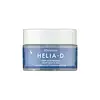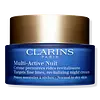What's inside
What's inside
 Key Ingredients
Key Ingredients

 Benefits
Benefits

 Concerns
Concerns

 Ingredients Side-by-side
Ingredients Side-by-side

Water
Skin ConditioningGlycerin
HumectantZea Mays Germ Oil
EmollientCetearyl Alcohol
EmollientPrunus Armeniaca Kernel Oil
MaskingPhenoxyethanol
PreservativeCarbomer
Emulsion StabilisingOenothera Biennis Oil
EmollientPolysorbate 20
EmulsifyingLinoleic Acid
CleansingPanthenol
Skin ConditioningTocopheryl Acetate
AntioxidantParfum
MaskingSodium Hyaluronate
HumectantHydrolyzed Caesalpinia Spinosa Gum
AbsorbentCetearyl Glucoside
EmulsifyingEthylhexylglycerin
Skin ConditioningSodium Hydroxide
BufferingOleic Acid
EmollientDisodium EDTA
Caesalpinia Spinosa Gum
Skin ConditioningPalmitic Acid
EmollientStearic Acid
CleansingHelianthus Annuus Seed Oil
EmollientRosmarinus Officinalis Leaf Extract
AntimicrobialPotassium Sorbate
PreservativeLinolenic Acid
CleansingTocopherol
AntioxidantDextran
Trifluoroacetyl Tripeptide-2
Skin ConditioningWater, Glycerin, Zea Mays Germ Oil, Cetearyl Alcohol, Prunus Armeniaca Kernel Oil, Phenoxyethanol, Carbomer, Oenothera Biennis Oil, Polysorbate 20, Linoleic Acid, Panthenol, Tocopheryl Acetate, Parfum, Sodium Hyaluronate, Hydrolyzed Caesalpinia Spinosa Gum, Cetearyl Glucoside, Ethylhexylglycerin, Sodium Hydroxide, Oleic Acid, Disodium EDTA, Caesalpinia Spinosa Gum, Palmitic Acid, Stearic Acid, Helianthus Annuus Seed Oil, Rosmarinus Officinalis Leaf Extract, Potassium Sorbate, Linolenic Acid, Tocopherol, Dextran, Trifluoroacetyl Tripeptide-2
Water
Skin ConditioningCetearyl Isononanoate
EmollientGlycerin
HumectantIsononyl Isononanoate
EmollientPropanediol
SolventCetearyl Alcohol
EmollientSucrose Polystearate
EmollientButyrospermum Parkii Butter
Skin ConditioningCetearyl Glucoside
EmulsifyingSodium Stearoyl Glutamate
CleansingParfum
MaskingCellulose
AbsorbentCetyl Palmitate
EmollientDipsacus Sylvestris Extract
Skin ConditioningCaprylyl Glycol
EmollientCarbomer
Emulsion StabilisingEthylhexylglycerin
Skin ConditioningTocopheryl Acetate
AntioxidantDisodium EDTA
Sodium Hyaluronate
HumectantActinidia Chinensis Fruit Extract
EmollientButylene Glycol
HumectantMarrubium Vulgare Extract
Skin ConditioningHedychium Coronarium Root Extract
MaskingPhenethyl Alcohol
MaskingFurcellaria Lumbricalis Extract
Skin ConditioningSodium Citrate
BufferingCitric Acid
BufferingLactic Acid/Glycolic Acid Copolymer
Skin ConditioningLapsana Communis Flower/Leaf/Stem Extract
Skin ConditioningMaris Sal
Skin ConditioningHeptapeptide-15 Palmitate
Skin ConditioningPolyvinyl Alcohol
Copper Palmitoyl Heptapeptide-14
Skin ConditioningWater, Cetearyl Isononanoate, Glycerin, Isononyl Isononanoate, Propanediol, Cetearyl Alcohol, Sucrose Polystearate, Butyrospermum Parkii Butter, Cetearyl Glucoside, Sodium Stearoyl Glutamate, Parfum, Cellulose, Cetyl Palmitate, Dipsacus Sylvestris Extract, Caprylyl Glycol, Carbomer, Ethylhexylglycerin, Tocopheryl Acetate, Disodium EDTA, Sodium Hyaluronate, Actinidia Chinensis Fruit Extract, Butylene Glycol, Marrubium Vulgare Extract, Hedychium Coronarium Root Extract, Phenethyl Alcohol, Furcellaria Lumbricalis Extract, Sodium Citrate, Citric Acid, Lactic Acid/Glycolic Acid Copolymer, Lapsana Communis Flower/Leaf/Stem Extract, Maris Sal, Heptapeptide-15 Palmitate, Polyvinyl Alcohol, Copper Palmitoyl Heptapeptide-14
 Reviews
Reviews

Ingredients Explained
These ingredients are found in both products.
Ingredients higher up in an ingredient list are typically present in a larger amount.
Carbomer is a polymer of acrylic acid. Its main role is to create a gel consistency.
A high amount of carbomer can cause pilling or balling up of products. Don't worry, most products contain 1% or less of carbomer.
Cetearyl alcohol is a mixture of two fatty alcohols: cetyl alcohol and stearyl alcohol. It is mainly used as an emulsifier. Emulsifiers help prevent the separation of oils and products. Due to its composition, it can also be used to thicken a product or help create foam.
Cetearyl alcohol is an emollient. Emollients help soothe and hydrate the skin by trapping moisture.
Studies show Cetearyl alcohol is non-toxic and non-irritating. The FDA allows products labeled "alcohol-free" to have fatty alcohols.
This ingredient is usually derived from plant oils such as palm, vegetable, or coconut oils. There is debate on whether this ingredient will cause acne.
Due to the fatty acid base, this ingredient may not be Malassezia folliculitis safe.
Learn more about Cetearyl AlcoholCetearyl Glucoside is a surfactant and emulsifier. It can be produced from synthetic of natural sources of cetearyl alcohol and glucose.
Emulsifiers help prevent ingredients from separating, such as oils and waters. It can also be used to enhance the texture of products.
As a surfactant, Cetearyl Glucoside helps during the cleansing process. By gathering all the dirt and oils, it allows these molecules to be washed away easily.
Learn more about Cetearyl GlucosideDisodium EDTA plays a role in making products more stable by aiding other preservatives.
It is a chelating agent, meaning it neutralizes metal ions that may be found in a product.
Disodium EDTA is a salt of edetic acid and is found to be safe in cosmetic ingredients.
Learn more about Disodium EDTAEthylhexylglycerin (we can't pronounce this either) is commonly used as a preservative and skin softener. It is derived from glyceryl.
You might see Ethylhexylglycerin often paired with other preservatives such as phenoxyethanol. Ethylhexylglycerin has been found to increase the effectiveness of these other preservatives.
Glycerin is already naturally found in your skin. It helps moisturize and protect your skin.
A study from 2016 found glycerin to be more effective as a humectant than AHAs and hyaluronic acid.
As a humectant, it helps the skin stay hydrated by pulling moisture to your skin. The low molecular weight of glycerin allows it to pull moisture into the deeper layers of your skin.
Hydrated skin improves your skin barrier; Your skin barrier helps protect against irritants and bacteria.
Glycerin has also been found to have antimicrobial and antiviral properties. Due to these properties, glycerin is often used in wound and burn treatments.
In cosmetics, glycerin is usually derived from plants such as soybean or palm. However, it can also be sourced from animals, such as tallow or animal fat.
This ingredient is organic, colorless, odorless, and non-toxic.
Glycerin is the name for this ingredient in American English. British English uses Glycerol/Glycerine.
Learn more about GlycerinParfum is a catch-all term for an ingredient or more that is used to give a scent to products.
Also called "fragrance", this ingredient can be a blend of hundreds of chemicals or plant oils. This means every product with "fragrance" or "parfum" in the ingredients list is a different mixture.
For instance, Habanolide is a proprietary trade name for a specific aroma chemical. When used as a fragrance ingredient in cosmetics, most aroma chemicals fall under the broad labeling category of “FRAGRANCE” or “PARFUM” according to EU and US regulations.
The term 'parfum' or 'fragrance' is not regulated in many countries. In many cases, it is up to the brand to define this term.
For instance, many brands choose to label themselves as "fragrance-free" because they are not using synthetic fragrances. However, their products may still contain ingredients such as essential oils that are considered a fragrance by INCI standards.
One example is Calendula flower extract. Calendula is an essential oil that still imparts a scent or 'fragrance'.
Depending on the blend, the ingredients in the mixture can cause allergies and sensitivities on the skin. Some ingredients that are known EU allergens include linalool and citronellol.
Parfum can also be used to mask or cover an unpleasant scent.
The bottom line is: not all fragrances/parfum/ingredients are created equally. If you are worried about fragrances, we recommend taking a closer look at an ingredient. And of course, we always recommend speaking with a professional.
Learn more about ParfumSodium Hyaluronate is hyaluronic acid's salt form. It is commonly derived from the sodium salt of hyaluronic acid.
Like hyaluronic acid, it is great at holding water and acts as a humectant. This makes it a great skin hydrating ingredient.
Sodium Hyaluronate is naturally occurring in our bodies and is mostly found in eye fluid and joints.
These are some other common types of Hyaluronic Acid:
Learn more about Sodium HyaluronateTocopheryl Acetate is AKA Vitamin E. It is an antioxidant and protects your skin from free radicals. Free radicals damage the skin by breaking down collagen.
One study found using Tocopheryl Acetate with Vitamin C decreased the number of sunburned cells.
Tocopheryl Acetate is commonly found in both skincare and dietary supplements.
Learn more about Tocopheryl AcetateWater. It's the most common cosmetic ingredient of all. You'll usually see it at the top of ingredient lists, meaning that it makes up the largest part of the product.
So why is it so popular? Water most often acts as a solvent - this means that it helps dissolve other ingredients into the formulation.
You'll also recognize water as that liquid we all need to stay alive. If you see this, drink a glass of water. Stay hydrated!
Learn more about Water